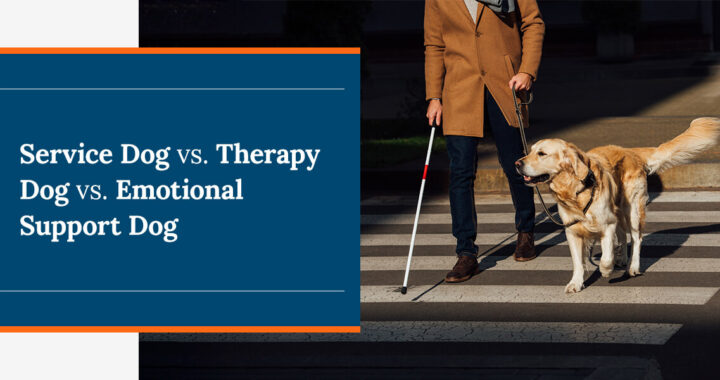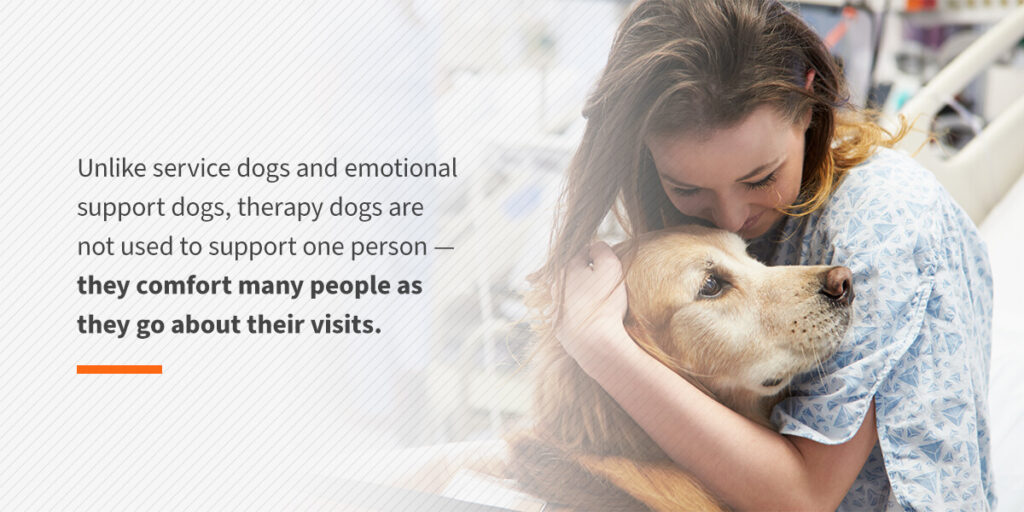Table of Contents
- What’s the Difference Between Service, Therapy and Emotional Support Dogs?
- What Rights Do Service Dog Owners Have?
- What Do Emotional Support Animals Do?
- Therapy Dog Roles
- How to Get Your Dog Certified as a Therapy Dog
- Get Certified Therapy Dog Training With Off Leash K9 Training Maryland
Dogs are caring, loyal companions. They bring us joy and help protect us when we feel stressed or unsafe. Service, therapy and emotional support companion dogs offer unique support for people with additional needs. This can include people with disabilities, people prescribed animal support and people residing in hospitals or nursing homes. Let’s compare therapy vs. emotional support vs. service dogs and how they each offer a service for individuals who require extra care and attention.
What’s the Difference Between Service, Therapy and Emotional Support Dogs?
While all dogs can bring comfort to us when we need it, some dogs receive specific training to provide services for people who might need extra assistance. Service, therapy and emotional support animals (ESAs) all have different roles to play — while they’re all dogs that help us in some way, these roles have different limitations and functions.
Service Dog
Service dogs are protected and regulated under the Americans with Disabilities Act (ADA). Not just any dog can become a service dog — service dogs are defined as dogs who are trained to perform tasks or do work for people with disabilities. These animals are not pets but working dogs. Their job is to provide a specific function for someone who requires extra assistance.
Some tasks service dogs are trained to perform include:
- Calming someone during a panic attack
- Reminding someone to take their medication
- Pulling a wheelchair
- Alerting someone who is deaf
- Guiding someone who is blind
- Alerting others and protecting someone during a seizure
These are not the only tasks service animals are trained to carry out — to be considered a service animals, dogs need individual training in a task directly related to someone’s disability.
Emotional Support Dog
Mental health professionals prescribe emotional support dogs for their patients. These dogs are typically prescribed to patients with diagnosed emotional or psychological disorders, including panic attacks, anxiety disorder and major depression. Emotional support animals provide comfort and security for their owners, supporting them when needed.
Therapy Dog
Therapy dogs aren’t trained to work for and live with a specific handler. Instead, they go with their handler — usually their owner — and visit facilities like schools, mental health facilities, hospitals, nursing homes and hospices. In these settings, the therapy animal’s purpose is to provide affection and comfort for residents. Unlike service dogs and emotional support dogs, therapy dogs are not used to support one person — they comfort many people as they go about their visits.
Since they go from place to place and visit lots of new people, therapy dogs are specifically trained to handle this work — therapy dogs should understand essential commands and listen well. They need gentle temperaments and must remain calm when interacting with unfamiliar places, sounds and people.
What Rights Do Service Dog Owners Have?
Since service dogs are protected under the ADA, service dog owners must receive reasonable accommodation for themselves and their dogs. Service dogs are permitted to go anywhere the public when accompanying a person with a disability. Even in spaces that normally don’t allow animals for health reasons, like restaurants, service dogs are permitted to accompany their person inside. While service dog owners can take their animals into public spaces, the dogs must remain under their handlers’ control at all times.
Additionally, service dog owners can only be asked two questions regarding their dogs:
- What task has the dog been trained to perform?
- Is the dog a service dog needed due to a disability?
Service dog owners do not have to disclose their disability or their dog’s documentation — these questions are protected under the ADA.
What Do Emotional Support Animals Do?
ESAs provide essential care and support services, easing loneliness, anxiety, depression and some phobias for their owners. They must be prescribed by a mental health professional who has evaluated their patient and determined that their life would benefit from an ESA.
Is an ESA the Same as a Service Animal?
Emotional support dogs are not service dogs. They don’t have the same protections under the ADA, and they’re not trained to perform a specific task for a person with disabilities. This is the main reason service dogs are not the same as emotional support dogs. This doesn’t make them any less essential to their owners, and they still provide critical care and support daily.
Therapy Dog Roles
Therapy dogs provide comfort and affection while remaining calm in various spaces. They should receive special training to ensure they can stay obedient and relaxed at all times. Their roles are to bring enjoyment into the lives of everyone they visit as they move through various clinical facilities. Therapy dogs might sit with children as they work on math or reading or visit sick patients in a hospital. Their job is to bring joy to other people instead of performing a role for their owners like service dogs and ESAs.
Can You Bring a Therapy Dog Anywhere?
Since therapy dogs aren’t exclusively working for people with disabilities, they aren’t protected under the ADA. Therapy dogs receive the same privileges as most pets — they’re permitted in public spaces and areas specifically designated for dogs. Additionally, dogs working as therapy animals will be allowed in various clinical facilities like hospitals with permission from the facility. Once established as therapy dogs at a facility, they can visit patients and residents as permitted.
How to Get Your Dog Certified as a Therapy Dog
To become a therapy dog, your pet needs therapy dog training from a certified evaluator. Completion of therapy training demonstrates that your dog understands and follows commands well. It will provide your pet with the training and techniques to ensure they remain calm and attentive in new and potentially stressful environments. Training helps your dog stay a happy and soothing presence as you take them through various clinical facilities to help residents.
Get Certified Therapy Dog Training With Off Leash K9 Training Maryland
Well-trained, certified therapy dogs can bring joy and comfort to people everywhere. Therapy dogs provide valuable support for residents and patients at clinical facilities. Getting your dog’s certification through a reputable, certified evaluator ensures your dog has the training and temperament for therapy work.
At Off Leash K9 Training Maryland, we’ll teach you and your dog the essential techniques and commands to ensure they are ready to handle the obedience requirements of being a therapy dog. We offer a therapy dog development program with eight private courses — four for basic commands and four specially tailored to your unique pet. After the course, we will evaluate your dog for certification. Enjoy many rewarding experiences with your therapy dog after receiving your certificate.
If you’re interested in certifying your pet as a therapy dog, sign up for our therapy dog training program today!



